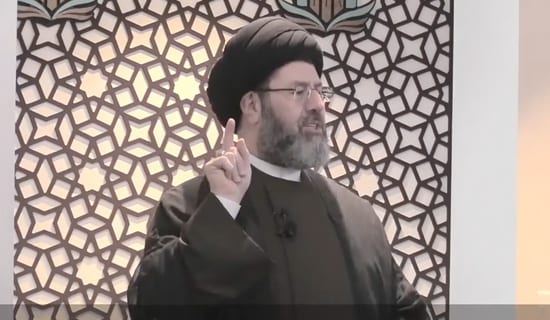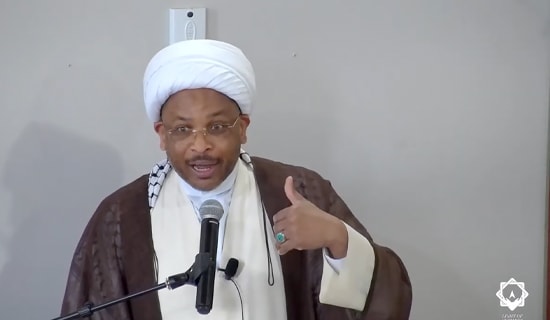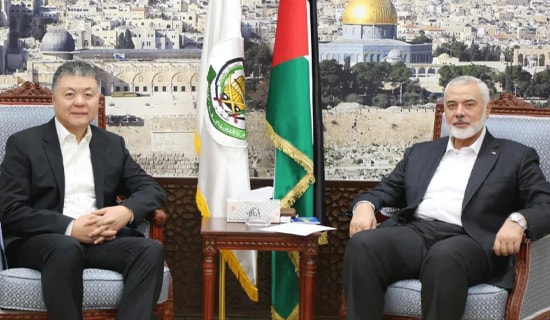Introduction
Since the Syrian regime and its allies, Iran and Russia, regained control of southern Syria in July 2018, there have been increasing reports on websites opposed to the regime of a growing presence of pro-Iranian forces in this region and close to Syria's borders with Israel and Jordan. For example, reports claimed that these forces are present only 5 km from the Israeli border, as well as at the Nasib border crossing on the Syria-Jordan border. If these reports are correct, they belie the claims of Russian officials, including Foreign Minister Sergei Lavrov, that the Iranian and pro-Iranian forces have retreated to a distance of over 100 km from the Israeli border.[1] Moreover, this will not be the first time Russian statements about the presence of pro-Iranian forces in this area have been misleading. These forces were also documented in southern Syria during the regime's campaign to regain control of this region, contrary to the understandings reached by Russia with Israel and Jordan prior to the campaign.[2] The reports on the anti-regime websites indicate that Russia is taking measures to prevent the entrenchment of the pro-Iranian forces in southern Syria, but the reports of these forces' growing presence in the region indicate that these measures a limited and cast doubt on Russia's ability or willingness to fulfill its commitments in this matter.
Gaining a foothold in southern Syria has long been a strategic objective of Iran and Hizbullah. The Syria war provided them with an opportunity to deploy there with the pretext of defending the Syrian regime and under the cover of the chaos in the area. Throughout the war, MEMRI has reported on Iran's efforts to consolidate its presence there,[3] efforts that have intensified since July 2018 and take place both on the military level, by amassing forces, recruiting locals and building bases in the area, and on the civil level, through rebuilding, charity and preaching activities.
This document reviews the recent reports on anti-regime websites about the presence of pro-Iranian forces in southern Syria and about Russia's efforts to prevent their entrenchment there.
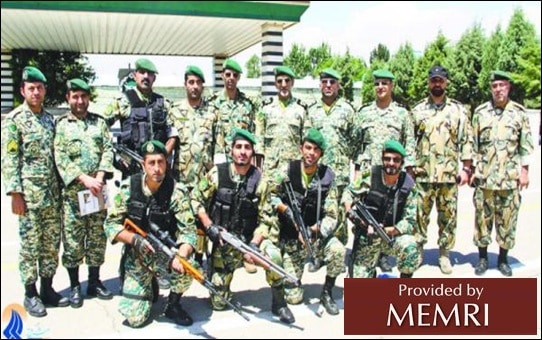
Iranian forces in Syria (image: Al-Sharq Al-Awsat, London, April 5, 2016)
Military Presence And Activity
According to the reports, the pro-Iranian forces operating in southern Syria, overtly and covertly, include the Shi'ite Iraqi Al-Imam Al-Hussein Brigade and Abu Al-Fadl Al-'Abbas Brigade, as well as the Al-Radwan Division, an elite Hizbullah force. For logistical reasons and in order to disguise their presence, these militias are deployed in Syrian army bases and are incorporated into its forces, reportedly wearing Syrian army uniforms and carrying Syrian flags. Syrian opposition official Fattah Hassoun claims that militia members have been incorporated into the regime's Fourth Division and Republican Guard.[4] It was also reported that Hizbullah, in cooperation with the Syrian regime, is acting to have Syrian ID cards issued to its operatives in Syria.[5]
Western Dara'a
The opposition website baladi-news.com reported on November 1, 2018 that, contrary to Russia's understandings with Israel and Jordan, "the Iranians move safely between their areas in Damascus and its environs, and have returned to southern Syria [as well]." The website claimed that Iranian and pro-Iranian forces are deployed along the Israeli border and in Syrian army bases in south Damascus and in the rural area of Dara'a. This is in addition to bases established by these forces in 2013-2018 in the area known as the "triangle of death" between Rif Dimashq, Quneitra and Dara'a.[6]
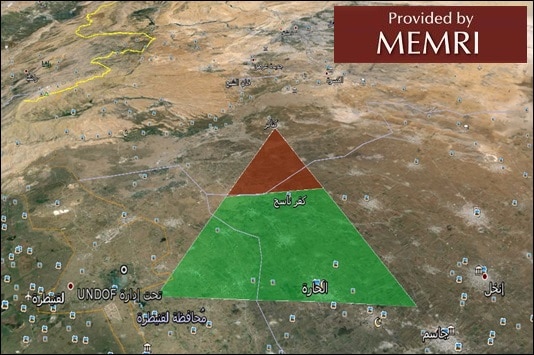
The "triangle of death" area (worldnews-sy.com, June 12, 2018)
Listing the localities where the Iranian and pro-Iranian forces are present, the website mentioned Dara'a, Khirbet Ghazaleh, Al-Ba'th, Khan Arnaba, Quneitra, Tal Al-Shayer, Tal Al-Shahem and Tal Mar'i.[7] Another opposition website reported that, for the last four years, Hizbullah has maintained military and training bases near the city of Izra' and the towns of Qarfa and Namer, and that Hizbullah has positions only 5 km from the Israeli border. It stated further that, since the regime regained control of the Quneitra governorate, Iranian forces deployed at the regime's Abu Diab Brigade military base in Tal Al-Hara and in the suburbs of Aqrab and Al-Tayha have been digging tunnels and bunkers to conceal their activity.[8] The daily Al-Quds Al-Arabi reported that pro-Iranian forces were also deployed in the Deir Al-'Adas area, some 15 km from the Israeli border.[9]

Source: Google Maps
The Nasib Border Crossing
The Nasib border crossing between Syria and Jordan, closed three years ago after the area fell to ISIS and Al-Qaeda, was reopened on October 15, 2018. Several days later, a Syrian opposition website posted that dozens of Hizbullah operatives had deployed at the crossing and in the old customs building in Dara'a, disguised as civilian customs officers.[10] In November the website reported that Hizbullah operatives had entered the town of Nasib and spray-painted walls with threatening messages such as "Hizbullah is coming" (see photo below). To disguise their identity they used vehicles belonging to militias affiliated with the Syrian regime.[11]
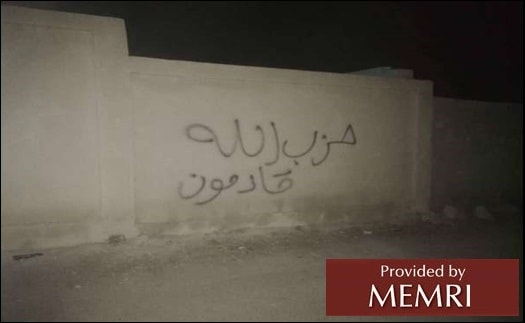
"Hizbullah is coming" on a wall in Nasib (Orient-news.net, November 13, 2018)
Eastern Dara'a
In October 2018 opposition websites reported that Syrian forces, along with Hizbullah and Shi'ite militias, had started laying infrastructure for military bases and weapons depos in the northeast of the Lajah region, about 50 km southeast of Damascus, and that these bases and depos would be under the oversight of the Iranian forces' war room near the Khalkhala airport in the northern Suweida governorate. This area was selected for its strategic location between Dara'a and the Iran-controlled areas east of the Euphrates, and also due to the rocky terrain which makes it easier to defend against airstrikes. According to the website, the regime razed several village in the area to make room for these bases, including Al-Shiyah, Hush Hamad, Al-Zaher and Al-Shumra.[12]
Recently, websites noted unusual movement of Syrian regime forces and pro-Iranian militias around bases in the northern Dara'a governorate. Reports claimed that, following attacks on Hizbullah bases in southern Damascus, and fearing further attacks, Hizbullah and the Syrian regime had begun moving their bases and OTR-21 Tochka missiles (SS-21) from that area to Lajah,[13] and that Hizbullah had also transferred missiles to Lajah from Lebanon.[14] This activity may indicate that the construction of the bases and depos in the Lajah area has been completed.
Hizbullah operatives have reportedly been sighted in the Al-Tha'la airbase and in the Al-Kokh area near Al-Suweida.[15]
Damascus
Throughout the years of the Syria crisis, Iran has acted to consolidate its presence in the Syrian capital of Damascus, especially in its old parts and suburbs. According to reports, pro-Iranian forces are present at the regime military base in Al-Mezzeh,[16] and many forces have been deployed in the Al-Sayeda Zainab area, sacred to the Shi'ites, the defense of which was the official pretext for the entry of the Shi'ite forces into Syria in the beginning of the war.
Some reports assert that Iran wishes to spread its control to southern Damascus as well, especially to towns whose inhabitants have fled due to the fighting, including Al-Hassania, Al-Sabina and Ghazal. Evidence of the growing Iranian presence and influence in Damascus and its environs is the Shi'ite 'Ashura ceremonies, which were held on an unprecedented scale already in 2014,[17] and the portraits of Khomeini and Hizbullah secretary-general Hassan Nasrallah that fill several areas, including the town of Al-Maliha.[18] Bases have reportedly been built in southern Damascus, in Tal Al-Madhi' and Tal Al-Mani', near Al-Kiswa,[19] which have been targets for airstrikes.
Training The Regime Army Forces
In addition to the forces deployed on the ground, Iran and Hizbullah military experts operate within the ranks of the Syrian army. The anti-Hizbullah Lebanese daily Al-Mudun reported that Hizbullah operatives train and supervise soldiers as part of Syrian army courses, teaching close quarters combat with emphasis on the use of light arms. According to the report, Hizbullah thus supervises tens of thousands of Syrian regular and reserve troops without being responsible for them financially or administratively, and while avoiding confrontations with Russia and Israel. As evidence, the report mentioned a course graduation ceremony of the Ninth Division, stationed in Al-Sanamayn, at which a senior army commander thanked "our brothers from Lebanon, of the Hizb[allah] organization, for their investment and efforts in training the fighters."[20]
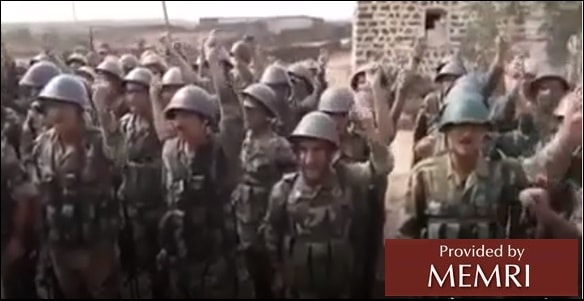
Syrian soldiers at a graduation ceremony of a course conducted by Hizbullah operatives (Al-Mudun, Lebanon, November 10, 2018)
Recruiting Local Fighters
As in other parts of Syria,[21] Iran has been acting to recruit locals to the ranks of the militias loyal to it, chiefly to Hizbullah, or to form local units close to the Israeli and Jordanian borders. This is intended to achieve two goals: expanding Iran's support base among the local population, and disguising its activity as activity by local forces, thereby ostensibly complying with the understandings between Russia, Israel and Jordan. As stated, this activity is not new. Already in 2013, Hizbullah established a Syrian branch and formed mechanisms for recruiting and training Syrian youths.[22]
SUPPORT OUR WORK

Recently, following the regime's takeover of southern Syria, opposition websites reported that Hizbullah had established recruitment offices in Dara'a,[23] and that the pro-Iranian militias offer recruits the option of choosing where to serve, and wages higher than those paid by the Syrian army.[24] One report claims that recruits who volunteer to serve in areas close to the Israeli border receive especially high wages.[25] They also offer exemption from serving in the Syrian army itself, and immunity from prosecution for defection or draft dodging. Alongside military training, the recruits receive lessons in Shi'ite Islam. [26]
The militias often enlist the help of local dignitaries in encouraging locals to sign up. Militia delegations visit villages and offer assistance in projects such as digging wells and renovating schools and homes in return for help in recruiting local youths, and also in return for permission to build Shi'ite schools in the area.[27]
The extent to which these efforts have been successful is unclear; opposition websites assess that about 1,600-2,250 locals have so far joined the Iran-backed militias.[28] Others, however, report that many locals oppose the recruitment efforts of these militias, and that Hizbullah and Shi'ite militia operatives have been driven out of many villages, especially in the eastern rural area of Dara'a.[29]
Civil Activity
In attempt to gain support among the local population and deepen its influence in the region, Iran is also acting on the civilian level, under the guise of charity activity, and is installing its representatives in local councils and purchasing large amounts of real estate in Syria.[30] In addition, it is acting to spread the Shi'a by establishing schools and colleges.[31]
A striking reflection of Iran's efforts to consolidate its presence in Syria with the cooperation of the Syrian regime was the visit made to Dara'a on October 24 by a delegation headed by Abu Al-Fadl Al-Tabtabai, the representative of Iranian Supreme Leader Ali Khamenei in Syria. The local branch of the ruling Al-Ba'th party reported the visit on its Facebook page, stating that the delegation had met with the branch secretary and with the Dara'a governor and police chief "to congratulate them on the victories of the Syrian regime and the friendly forces that support it in the governorate."[32]
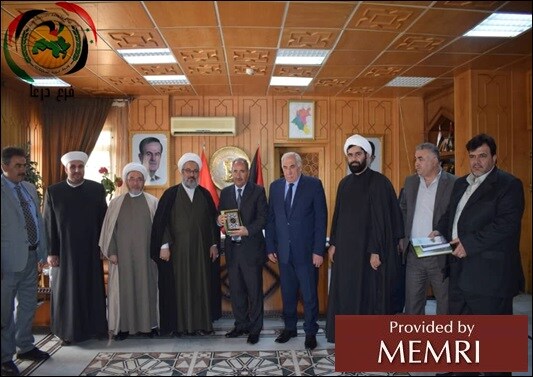
The Iranian delegation on its visit to Dara'a (Albaath.daraa, October 24, 2018)
A correspondent for the Lebanese Al-Mudun daily reported that the delegation met with military and security officials, but that, when touring the area, it was accompanied by religious and judiciary figures only, in order to give the visit a civilian and religious appearance. According to the correspondent, the delegation members stressed that Iran regards Dara'a as highly strategic due to its proximity to the Israeli border, as reflected by the deployment of many Iran-backed forces in the region, compared to other parts of Syria. They also noted that Khamenei had instructed them to invest every effort in aiding the people of the Dara'a governorate, and that this would be expressed in infrastructure and rebuilding projects.[33] One report claimed that, following the visit, a branch of a Shi'ite religious organization was established in the area.[34]
Limited Russian Measures To Prevent Iran's Entrenchment On The Border
As mentioned, the presence of Iran-backed forces near the Israel and Jordan borders contravenes Russia's understandings with these countries as well as Russian statements that the forces have retreated 100 km from the Israeli border. In a further effort to reassure Israel, Russian officials also stated that Russian police forces would be deployed along the border to assist UNDOF in enforcing the 1974 disengagement agreement.[35] UN deputy spokesman Farhan Haq stressed that the Russian forces were not part of UNDOF.[36]
Anti-Syrian regime websites claim that Russia has taken some measures to tighten its control in southern Syria and to ensure the implementation of the reconciliation agreements between the regime and the rebels there, of which it is a guarantor. They also report that Russia is making efforts to recruit locals to the Syrian army units that are under its control, such as the Fifth Division, and that as part of this it has enlisted former rebel commanders who signed reconciliation agreements with the regime in the Dara'a governorate to oversee the implementation of the agreements. One report stated that these officers were taking a month-long course at the Russian Hmeimim airbase, and that they would earn a monthly salary of $200 and be subordinate to the Russian forces rather than the Syrian regime. Eventually they would be incorporated into the Fifth Division.[37]
Furthermore, in mid-October, at the time of the reopening of the Nasib border crossing, it was reported that Russia was negotiating with Jordan to form a Sunni force under the control of former rebel commanders, some of whom had been sheltering in Jordan, that would prevent the entrenchment of pro-Iranian forces along the Jordanian border and ensure the presence of an element friendly to Jordan in that region.[38] The outcome of these negotiations is so far unknown.
However, the reports reviewed above about Iran's entrenchment on Syria's borders with Israel and Jordan cast doubt on the efficacy of these Russian measures and suggest that Russia may in fact be using the threat of Iranian presence to pressure Israel and Jordan and position itself as a potential mediator, should this become necessary.
* N. Mozes is a research fellow at MEMRI.
[1] Sputniknews.com, September 28, 2018.
[2] See MEMRI Inquiry & Analysis No. 1408, Contrary To The Understandings Reached With Russia, Iranian And Iran-Affiliated Forces Are Participating In The Fighting In Southern Syria, July 19, 2018; Special Dispatch No. 7581, Hizbullah Officials: We Haven't Withdrawn From Southern Syria; The Power Balance Has Shifted In Favor Of Assad And His Allies, July 23, 2018.
[3] Special Dispatch No. 6039, Board Chairman Of Pro-Hizbullah Lebanese Daily: Hizbullah Has Established Resistance Infrastructure In Syrian Golan In Cooperation With Locals, April 30, 2015; Inquiry & Analysis No. 1138, Following Killing Of Hizbullah Operative Jihad Mughniyah, New Information Comes To Light Regarding Hizbullah, Iranian Activity In Syrian Golan On Israeli Border, January 28, 2015; MEMRI Daily Brief No. 1146, From The Mediterranean to the Golan, Iran Builds Active Front And Direct Military Presence On Israel's Border To Deter Israel And Further Ideology Of Eliminating The Zionist Regime, February 16, 2015; Inquiry & Analysis Series No. 1157, Iran Tightens Its Grip On Syria Using Syrian And Foreign Forces, May 4, 2015.
[4] Al-Quds Al-Arabi (London), August 17, 2018.
[5] Special Dispatch No. 7770, Anti-Syrian Regime Websites: Regime Granting Citizenship To Millions Of Iranians, Hizbullah Operatives To Change Country's Demographics From Sunni To Shi'ite Majority, Conceal The Fighters' Presence In Syria, November 12, 2018.
[6] The Lebanese Al-Mudun daily, which opposes Hizbullah, reported about these bases on February 12, 2017.
[7] Baladi-news.com, November 1, 2018.
[8] Stepagency-sy.net, November 26, 2018.
[9] Al-Quds Al-Arabi (London), August 17, 2018.
[10] Orient-news.net, October 21, 2018.
[11] Orient-news.net, November 13, 2018.
[12] Orient-news.net, October 14, 2018.
[13] Stepagency-sy.net, December 5, 2018.
[14] Baladi-news.com, December 5, 2018.
[15] Al-Quds Al-Arabi (London), August 17, 2018.
[16] Baladi-news.com, November 1, 2018.
[17] See MEMRI Inquiry & Analysis No. 1131, Shi'ization Of Syria: In Damascus, Unprecedentedly Extensive Observance Of The 'Ashura, November 13, 2014.
[18] Baladi-news.com, December 4, 2018.
[19] Baladi-news.com, December 5, 2018.
[20] Al-Mudun (Lebanon), November 10, 2018.
[21] See MEMRI Special Dispatch No. 7790, Syrian Opposition Websites: Iran Consolidating Its Presence In Eastern Syria, West Of Euphrates, To Form Continuum From Iran, Through Iraq And Syria, To Mediterranean, December 4, 2018.
[22] See MEMRI Inquiry & Analysis Series No. 1157, Iran Tightens Its Grip On Syria Using Syrian And Foreign Forces, May 4, 2015.
[23] Nedaa-sy.com, October 14, 2018.
[24] Zamanalwsl.net, October 8, 2018.
[25] Syriahr.com, November 12, 2018.
[26] Zamanalwsl.net, October 8, 2018.
[27] Zamanalwsl.net, October 8, 2018.
[28] Neda-sy.com, October 14, 2018; Stepagency-sy.net, November 26, 2018.
[29] Arabi21.com, October 21, 2018.
[30] Al-Arabi Al-Jadid (London), November 17, 2018.
[31] Baladi-news.com, October 16, 2018.
[32] Facebook.com/Albaath.daraa, October 24, 2018.
[33] Al-Mudun (Lebanon), October 25, 2018.
[34] Al-Arabi Al-Jadid (London), November 17, 2018.
[35] The United Nations Disengagement Observer Force (UNDOF) was established in May 1974 to implement the ceasefire between Israel and Syria. Its forces have now returned to the area after leaving it in 2014 following the abduction of dozens of its members by Al-Qaeda-affiliated militants.
[36] Webtv.un.org, August 3, 2018.
[37] Zamanalwsl.net, October 20, 2018.
[38] Facebook.com/mohammad.alsharaa.58, October 14, 2018; nedaa-sy.com, October 16, 2018.


